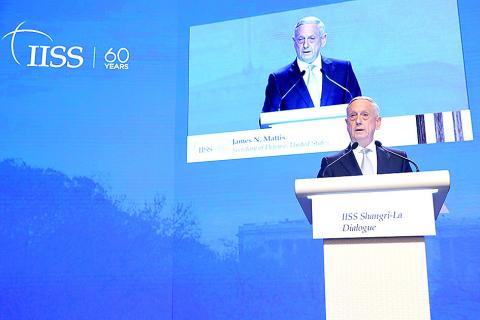The world has to deal with China’s militarization of the South China Sea for now, but Beijing would face “larger consequences” in the long term that could persuade it to change track, US Secretary of Defense James Mattis said yesterday.
Beijing’s deployment of missile batteries and bombers to outposts in disputed areas appear aimed at intimidating its neighbors, Mattis told delegates at the International Institute for Strategic Studies’ Shangri-La Dialogue in Singapore.
Such moves had caused the US to reconsider its “cooperative stance” and disinvite China from the Rim of the Pacific Exercise later this month, he added.

Photo: Bloomberg
That was a relatively small penalty for China to pay and the region would be “dealing with the reality” of its territorial claims over a vital global shipping route, Mattis said.
“I believe there are much larger consequences in the future, when nations lose the rapport of their neighbors,” Mattis told reporters after his speech.
He also attacked what he said were excessive loans made under China’s Belt and Road Initiative that were binding smaller nations in debt.
“Eventually, these things do not pay off, even if on the financial ledger sheet or the power ledger sheet they appear to,” he said. “It’s a very shaky foundation when we believe that militarizing features are somehow going to endorse their standing in the world.”
Mattis’ comments appeared to reaffirm the US’ commitment to Asia’s security, even as US President Donald Trump’s decisions to levy tariffs on allies and withdraw from international agreements have raised questions about its post-World War II alliances.
Challenged from the floor of the conference by several delegates, Mattis gave a forceful defense of the US’ commitment to its allies in the region, stretching back to former US president Thomas Jefferson.
“We have seen those who wanted to dominate the region come and go, and we have been with you,” Mattis said. “It’s not based on which party is in power.”
The Philippines has already sought accommodation with China over its South China Sea claims, but US House Committee on Armed Services Chairman Mac Thornberry told reporters he believes that attitudes to China in the region are hardening.
“It’s clear to me from the conversations I’ve had, not just the past week, but beyond, that China’s actions are increasingly alienating many countries, because they threaten the ability of countries to determine their own future, to provide for their people,” Thornberry said. “I think the larger trend is that countries are coming together to say this is unacceptable.”
In an exchange with Mattis, Senior Colonel Zhao Xiaozhuo (趙小卓), deputy director of the Center on China-US Defense Relations in China’s Academy of Military Science, said that sending warships into Chinese territorial waters was a violation of the nation’s law.
“Mattis’ speech was negative,” Zhao said. “If China’s islands and reefs are continuously threatened by activities under the name of so-called freedom of navigation, China will eventually station troops on these reefs.”
“We did not do freedom of navigation for America alone,” Mattis said. “We do freedom of navigation, give freedom for all nations, large and small, that need to transit those waters for their own prosperity and they have every reason to do so.”
Beijing sent a relatively low-level delegation to this year’s forum, where the US and its allies dominate. No Chinese official was scheduled to give the traditional Sunday speech, in what had become an outlet for a riposte to the US speech the day before.

Seventy percent of middle and elementary schools now conduct English classes entirely in English, the Ministry of Education said, as it encourages schools nationwide to adopt this practice Minister of Education (MOE) Cheng Ying-yao (鄭英耀) is scheduled to present a report on the government’s bilingual education policy to the Legislative Yuan’s Education and Culture Committee today. The report would outline strategies aimed at expanding access to education, reducing regional disparities and improving talent cultivation. Implementation of bilingual education policies has varied across local governments, occasionally drawing public criticism. For example, some schools have required teachers of non-English subjects to pass English proficiency

‘FORM OF PROTEST’: The German Institute Taipei said it was ‘shocked’ to see Nazi symbolism used in connection with political aims as it condemned the incident Sung Chien-liang (宋建樑), who led efforts to recall Democratic Progressive Party (DPP) Legislator Lee Kun-cheng (李坤城), was released on bail of NT$80,000 yesterday amid an outcry over a Nazi armband he wore to questioning the night before. Sung arrived at the New Taipei City District Prosecutors’ Office for questioning in a recall petition forgery case on Tuesday night wearing a red armband bearing a swastika, carrying a copy of Adolf Hitler’s Mein Kampf and giving a Nazi salute. Sung left the building at 1:15am without the armband and apparently covering the book with a coat. This is a serious international scandal and Chinese

TRADE: The premier pledged safeguards on ‘Made in Taiwan’ labeling, anti-dumping measures and stricter export controls to strengthen its position in trade talks Products labeled “made in Taiwan” must be genuinely made in Taiwan, Premier Cho Jung-tai (卓榮泰) said yesterday, vowing to enforce strict safeguards against “origin laundering” and initiate anti-dumping investigations to prevent China dumping its products in Taiwan. Cho made the remarks in a discussion session with representatives from industries in Kaohsiung. In response to the US government’s recent announcement of “reciprocal” tariffs on its trading partners, President William Lai (賴清德) and Cho last week began a series of consultations with industry leaders nationwide to gather feedback and address concerns. Taiwanese and US officials held a videoconference on Friday evening to discuss the

PERSONAL DATA: The implicated KMT members allegedly compiled their petitions by copying names from party lists without the consent of the people concerned Judicial authorities searched six locations yesterday and questioned six people, including one elderly Chinese Nationalist Party (KMT) member and five KMT Youth League associates, about alleged signature forgery and fraud relating to their recall efforts against two Democratic Progressive Party (DPP) legislators. After launching a probe into alleged signature forgery and related fraud in the KMT’s recall effort, prosecutors received a number of complaints, including about one petition that had 1,748 signatures of voters whose family members said they had already passed away, and also voters who said they did not approve the use of their name, Taipei Deputy Chief Prosecutor